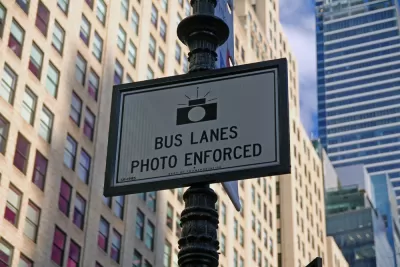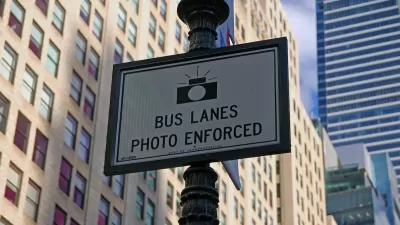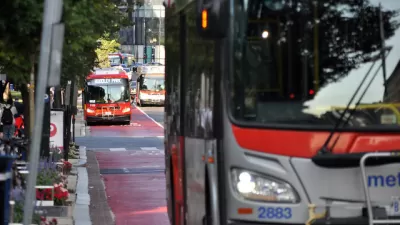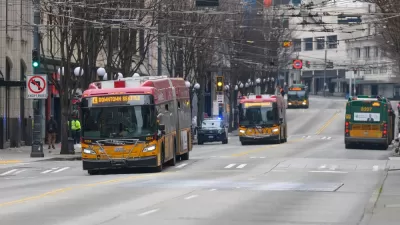The city hopes to improve the speed of its notoriously slow buses by using traffic cameras to ticket drivers who drive or park in dedicated bus lanes.

“Despite New York’s 140 miles of dedicated bus lanes, other large U.S. cities put it to shame when it comes to average bus speed,” writes Danielle Muoio Dunn in Politico, with some buses clocking in at half the average speed of other major cities. “Despite having dedicated access, vehicles parked in bus lanes continue to mar the city’s efforts to dramatically improve speeds and service reliability.”
Now, the city plans to use traffic cameras to issue citations for the notoriously common practice of blocking bus lanes. “During a 20-minute ride along the entire 42nd Street bus lane on a Thursday afternoon in August, POLITICO counted 11 vehicles idling or parked in the busway — including a UPS truck, taxis and SUVs and a commercial delivery van. One car used the bus lane to cut ahead of the gridlock traffic in Times Square, temporarily blocking access as it attempted to merge back into the crowded lane.”
After convening at a Transit Improvement Summit, transit officials committed to installing 50 additional cameras in bus lanes. “Meanwhile, the MTA recently awarded a contract to California tech startup Hayden AI to mount 300 more cameras on buses — bringing its automated enforcement program to 473 buses by the end of this year.” In 2021, the camera program captured more than 600,000 violations.
The article notes that “The tickets have an impact. Less than 20 percent of drivers who are issued a bus lane violation go on to commit another, according to the MTA, which started tracking the data in 2019 when it began mounting cameras on buses. Only 8 percent of motorists have gone on to commit more than two violations.”
FULL STORY: Can camera enforcement speed up New York's sluggish buses?

Alabama: Trump Terminates Settlements for Black Communities Harmed By Raw Sewage
Trump deemed the landmark civil rights agreement “illegal DEI and environmental justice policy.”

Planetizen Federal Action Tracker
A weekly monitor of how Trump’s orders and actions are impacting planners and planning in America.

The 120 Year Old Tiny Home Villages That Sheltered San Francisco’s Earthquake Refugees
More than a century ago, San Francisco mobilized to house thousands of residents displaced by the 1906 earthquake. Could their strategy offer a model for the present?

Opinion: California’s SB 79 Would Improve Housing Affordability and Transit Access
A proposed bill would legalize transit-oriented development statewide.

Record Temperatures Prompt Push for Environmental Justice Bills
Nevada legislators are proposing laws that would mandate heat mitigation measures to protect residents from the impacts of extreme heat.

Downtown Pittsburgh Set to Gain 1,300 New Housing Units
Pittsburgh’s office buildings, many of which date back to the early 20th century, are prime candidates for conversion to housing.
Urban Design for Planners 1: Software Tools
This six-course series explores essential urban design concepts using open source software and equips planners with the tools they need to participate fully in the urban design process.
Planning for Universal Design
Learn the tools for implementing Universal Design in planning regulations.
Clanton & Associates, Inc.
Jessamine County Fiscal Court
Institute for Housing and Urban Development Studies (IHS)
City of Grandview
Harvard GSD Executive Education
Toledo-Lucas County Plan Commissions
Salt Lake City
NYU Wagner Graduate School of Public Service





























